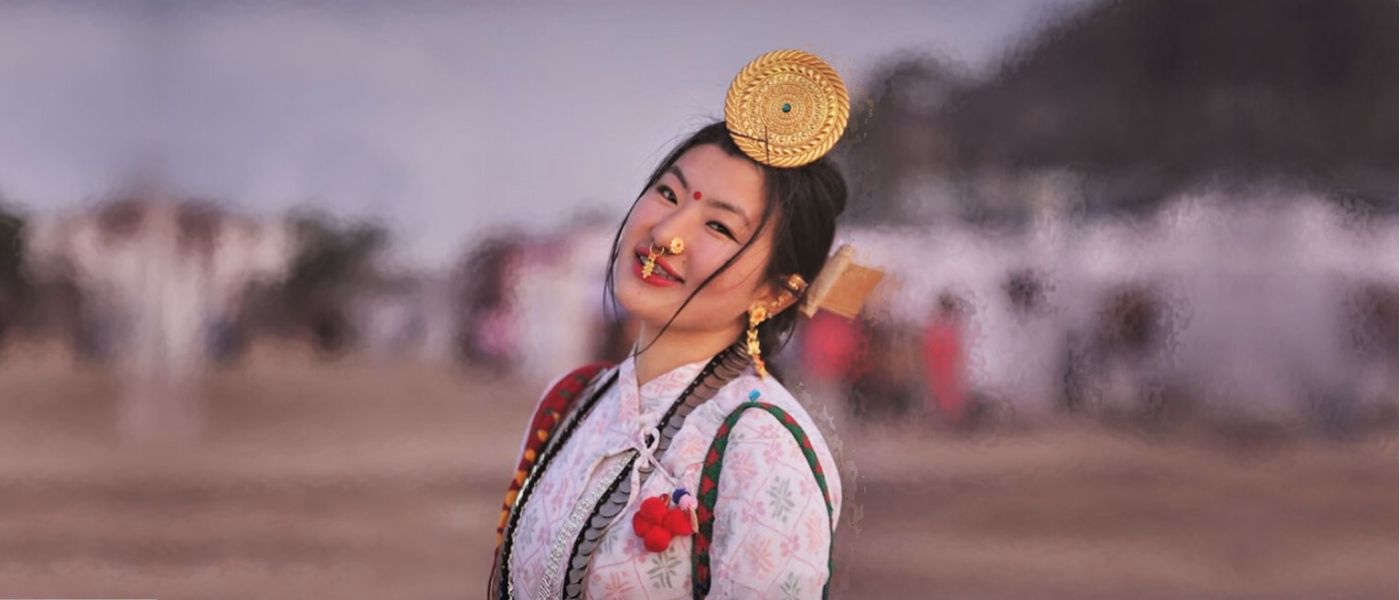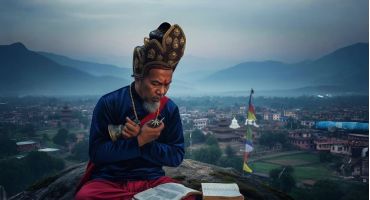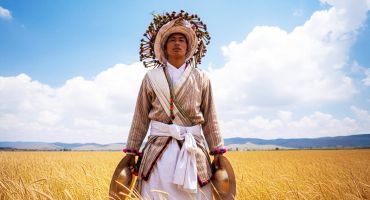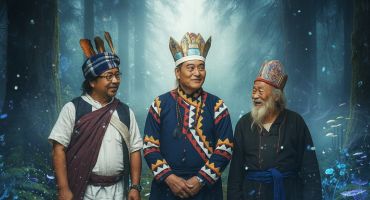Bantawa Rai of the Amchoke region have a unique way of celebrating the yearly Ubhauli or Dongwanga (Beginning of monsoon and plantation).
According to legend, Khuirum Hangkhim and Namnu, who were related as son-in-law and father-in-law once chased a wild boar, which was eventually struck by their arrows at Mayung Lake (present-day Bhojpur). After the fatal strike, the boar fell to the ground and transformed into a stone in the shape of a deity, which became attached to a Gagun tree (Saurauia nepalensis). The boar was a forest deity in disguise, which they recognized as a Maang (deity) in the form of Sakenwalung, believed to bring great fortune to their village. This made them gather things for worship like ginger, water and Rice grains. After carrying out necessary rituals for the deity, Namnu requested the deity to come along with them to their village, and so the deity agreed.
They were overwhelmed with happiness and placed the Sakenwalung in their Thumsey (traditional wicker basket), dancing and singing. On their way home, at Chabung Buktang, east of the Bungwa River, Khuirum Hangkhim slipped, and the Sakenwalung fell from the Thumsey, getting impaled into the ground. After multiple attempts to remove it, they were unsuccessful and concluded that the deity had decided to stay there forever. They then placed other necessary items of worship and made it the Chongkha Sakenwa Than, a shrine where the people of the region could come for the annual worship of Mother Nature.
This story reveals the origins of the Chongkha Sakenwa Than. A recent discovery uncovered a giant brass bell dating back 200 years, said to be one of the oldest pieces of evidence that shapes the history of the Chongwa Sakenwa Thetlum (Than or Shrine).

Present day Mabjok region.
Above the Dudh kosi river, present day Dhintang, Chimawa, Bayang, Siddhathan were the areas of Mangpahang Bantawa living in 12 villages and the River Bungwa Hongku presently flowing in the Amchoke region. It covers the borders of Khotang and Bhojpur, runing between them. The Chongkha Sakenwa than is present in the Khotang side above the Bungwa river which borders Bhojpur.
These days Chongkha Sakenwa is specially celebrated by Khambu Rai of Amchoke region like Mangpahang, Hangkhim and Tanglukwa. Their 10 groups of generation are the ones who still carry out the traditional way of performing Chongkha Sakenwa.
10 elders from each 10 lineages who are also the head shamans of their respective branches, are often referred to as the 10 pagari or 10 Kirat who are the leaders of the overall region in both social, economic and spiritual issues.
They are named according to their age and designation like Jetha, Maila, Saila, Kaila1, Kaila 2, Thaila 1, Thaila 2, Thulo Kancha, Sano Kancha and Kancha. They have respective villages where they live with their own family like Namanta, Dambarkha, Chongkha, Dhangkha, Bhopung, Khawa, Makhuwa, Chumarang, Bhir Goan and Wasingthapu.
Chongkha Sakenwa takes place between the months of Jeth and Mangsir, after the monsoon has already begun. People are filled with excitement for their annual celebration, preparing food items, drinks, and roosters for sacrifice in advance.

On the first day:
Yamang tonma: It’s the day when the people ask for water to the deity of Sakenwa than, on Monday of Baishake Purnima. On this day all the 10 pagari or the Nachong(priest) take bath, and take out all the items that were kept safely after the last winter celebration of Udhauli. The entire family collectively moves toward the Sakenwa Than, playing the Dhol (Drum) and Jyamta (Cymbals). All 10 pagari from each family meet along the way to the destination, with some arriving early. Once all 10 pagari Nachong have gathered, the worship begins. After all the rituals the liquor that is brought is served to everyone, which ends the 1st day.
One month later:
Khalappa mang or Bhumi Puja: is carried out in respective Pagari’s land to please the deities before the grand celebration. All the villagers bring Hengmawa/Raksi (traditional alcohol) for offering, which is later distributed in between the people. And money is also collected from everyone for the celebration of Chongkha Sakenwa. All the expenditures are calculated and plans are made on this day.

Day before the celebration:
After Jeth and Mangsirey Purnima, the following Saturday, all the houses in the village is cleansed and Diwa Puja or Ancestral worship is performed. All the Dhol (traditional drums) and Jyamta(cymbals) are taken out by the Nachong and is washed and dipped in water of the nearby stream or creek for one night. Next day the animal skin is replaced by a new one, and all the items are cleansed by the Nachong to be used.
Sohan chakwa or pure water from the main source is used to perform all the cleansing works. The Samkhalung/Teen Chula (Hearth Stones) is worshipped and all the ancestors are remembered. Mundum is chanted for overall improvement with a sacrifice of a Rooster.
After the work in the house the villagers move towards the part of the hill which falls under the land of the Nachong in all the 10 pagari villages. Dewa Puja is the rituals performed in the land of each 10 pagari. Where all the instruments are taken out and Semuna silli or Sakenwa Lakcham of Bantawa Rai is performed. And after the worship all the villagers move to their houses for the preparations for the next day.

Main day:
All the Nachong take ritual bath and all the roosters are also washed which are ready for the sacrifice on the main place. All families in the village pray for overall welfare of the family and society. In their specific villages the Nachong is congratulated and his Sayachongma (head raising ceremony) is done by the villagers. Then everyone moves towards the Sakenwa than playing the Dhol and Jyamta dancing along the way. The whole atmosphere of the region becomes very pleasant.
A special dance form of the Bantawa Rai called Sakenwa Lakcham is done by everyone present and upon reaching the place all the drummers walk inside the Sakenwa than playing the Dhol by which it is believed that the negative spirits residing in that place is scared by the sound and wards off. Then all the 10 pagari according to their age and designation perform all the religious works and offer sacrifices to the deity. Turn wise all the 10 pagari finish the work and the people are then allowed to perform offering rituals.
After all the religious work, everyone dances the Sakenwa Lakcham with great energy and happiness ending the celebration of Sakenwa. Then on that same day, 3 km away from the Sakenwa than a big annual fair is carried out called the Mangsirey Mela, which the locals visit after the celebration till end of the day.





Leave a Reply